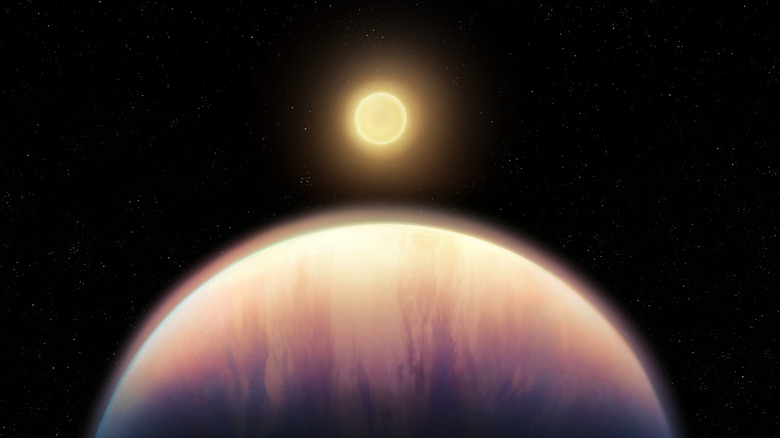The Fascinating Way Astronomers Found A New Planet That's 3,200 Light-Years Away From Earth
As surprising as it may sound, we still don't know how many solar systems are in our galaxy. Given the incredible discoveries being made about space all the time, it might seem as though we have a good grasp on how many planetary systems exist within our neighborhood of the cosmos, but like so much of the universe, the actual number remains a mystery. That doesn't mean we're not constantly discovering new planets and stars all the time, though.
In just the past few years, there have been some incredible discoveries light years outside of our own solar system that simply wouldn't have been possible in prior decades. Scientists have been tracking a rare planet unlike anything in our solar system since 2009, and that particular exoplanet (a planet that exists outside our own solar system) looks to be a completely new type of world that defies classification. Then, there was the 2023 discovery made by scientists using the James Webb Space Telescope (JWST) of a potential biosignature on a planet known as K2-18 b, which brought us one step closer to discovering extraterrestrial life.
Now, astronomers have found a new exoplanet which sits 3,200 light years away from Earth in a fairly remote area of the Milky Way. But this particular planet is just as interesting for the way in which it was discovered as it is for being yet another fascinating alien world at the very edge of our galaxy.
The distant planet at the edge of our galaxy
Incredibly, astronomers are able to look far beyond even the Milky Way, and we have already identified the biggest known structure in the universe, the Hercules-Corona Borealis Great Wall, which sits a staggering 10 billion light-years away from our own planet. But there are still a seemingly infinite amount of discoveries to be made closer to home. Our galaxy measures 100,000 light-years across (1 light-year is 5.88 trillion miles) and contains an unfathomable amount of alien worlds just waiting to be discovered. The latest example is the identification of the planet AT2021uey b, which was not only found in an unexpected area within the Milky Way, but discovered using a novel method that relies on a rare phenomenon.
As detailed in a study published in the journal Astronomy & Astrophysics, this Jupiter-sized gas giant sits at roughly 3,200 light-years from Earth in an area outside of what's known as the galactic bulge — the central, bulging region of the Milky Way. This area isn't quite as dense with the types of elements required to form planets, and as such, the discovery of AT2021uey b, which orbits a small M dwarf star, is a remarkable find. In fact, this is only the third planet to ever be identified so far away from the galactic bulge.As exciting as that is, the method used to identify the planet is perhaps just as compelling, as it made use of a rare space-time phenomenon that was first suggested by Albert Einstein.
Scientists used an unorthodox method to identify this new planet
In order to identify AT2021uey b, researchers from Vilnius University (VU) Faculty of Physics, alongside colleagues from multiple other countries, used a technique known as gravitational microlensing. This refers to a phenomenon whereby light from a star is magnified by a planet's gravity warping space-time itself. This allows observers to identify a massive cosmic body, such as a star or planet, by watching as an object positions itself directly in front of a distant star, thereby warping and amplifying the light from that star and essentially making itself visible in the process. The temporary light "pulsation" that results from this rare occurrence allows astronomers to see planets and other cosmic bodies that are otherwise incredibly difficult to identity.
This rare microlensing phenomenon was predicted by Albert Einstein in the early 20th century. His 1936 article "Lens-Like Action of a Star by the Deviation of Light in the Gravitational Field," provided an explanation of the basis for microlensing, and now researchers have used that very phenomenon to identity AT2021uey b.
Head of the Lithuanian research team, Dr. Marius Maskoliūnas, explained in a statement (via Phys.org) that using microlensing to identify planets is incredibly painstaking work and Dr. Maskoliūnas explains, "This kind of work requires a lot of expertise, patience, and, frankly, a bit of luck." Waiting for the star and the planet to align can take a very long time, and Dr. Maskoliūnas further notes, "95% of observed stars pulsate for various other reasons, and only a minority of cases show the microlensing effect." What's more, most microlensing effects have been recorded at the center of our galaxy, whereas this particular discovery was made in an area known as the galactic halo. Without microlensing and Einstein's work on establishing our understanding of such a phenomenon, we would never have known this planet existed or indeed that planets could exist in this region.


